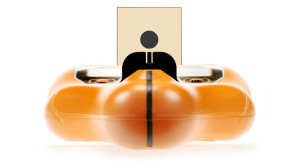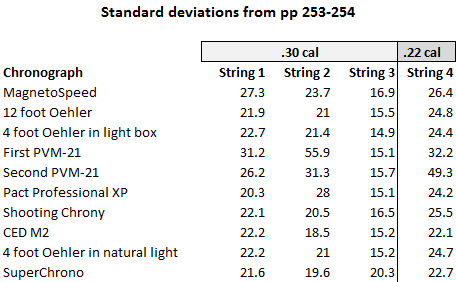Chronograph test in «Modern Advancements in Long Range Shooting Vol I» by Bryan Litz
In his book «Modern Advancements in Long Range Shooting Vol I», Bryan Litz dedicates chapter 15 to the testing of chronographs. On page 221 he sets out the following criteria for evaluating chronographs:
- ”Accuracy is the ability of the chronograph to measure the true average velocity for a string of shots.”
- “Precision is the ability to resolve the true extreme spread and standard deviation of a string of shots.”
A total of ten chronographs from eight producers were tested against these criteria. The chronographs were placed one after the other, see table at bottom of post for sequence. 30 shots .308 Win and 10 of .223 Rem were fired during the test.
Accuracy: True average velocity
On page 246 a table shows the deviations of mean velocity between an Oehler with 12 ft sensor spacing and placed indoors in controlled light, and the SuperChrono. The deviations and bullet velocities are as follows:
Before we can say anything about these deviations we need to check whether they are consistent over the two shot series. We know that you have to set the SuperChrono up meticously and open the Precision calculator to check for aiming errors. This is a spreadsheet with formulas taking into account the effects bullet velocity, speed of sound, angles and the distance between sensors. The input to the formulas are the orange fields shown in the screenshots below.
Page 240 tells us that shooting distance was 300 yards, 274m, and enter this value along with the velocity of 870 m/s for the first string. We estimate the temperature to be 20C. We enter values in the field “Aiming error at target, over or under parallel line” until the deviation in ft/s is 41. We arrive at 170cm of aiming error.
Skipping to the 22 cal string we enter the bullet speed of 990 m/s:
With the same aiming error as before we get a deviation of -54 ft/s. Close enough to say that the author didn’t properly align the chronograph. His aim is 1.7m or 67” off at 300 yards. That’s akin to placing the sights on a car tire at 100yds. Anybody can do that. All you have to do is align the sights with target as shown below:
With this new information we can update the table on page 246:
The corrected table shows the SuperChrono as the most accurate chronograph and with the same average velocity as the 12 foot Oehler.
Precision: True extreme spread and standard deviation
The table referred to on page 246 addresses deviations from the 12 foot Oehler. To check for overall precision we turn to the data tables and the standard deviations derived from the shot strings. The following table has been constructed from the data on pages 253-254. The SD for String 1 for MagnetoSpeed is higher than in the book. The number shown here is the one calculated by Excel.
To get a clearer picture we rank the SD low-high within each string and sum for total rank:
Conclusion: The most precise chronograph is the CED M2 with the SuperChrono in third place.
What’s surprising from the SD tables is the poor performance of the two PVM-21. This is the established European and arguably the World’s reference chronograph. Its velocity readings have been verified by high-speed camera. Leading German shooting magazines such as Visier and Caliber use it to test ammo and guns in every issue. We at Steinert Sensing Systems have used it ourselves and find it inconceivable that it doesn’t perform at the very top in this test.







